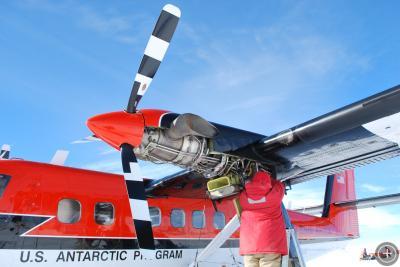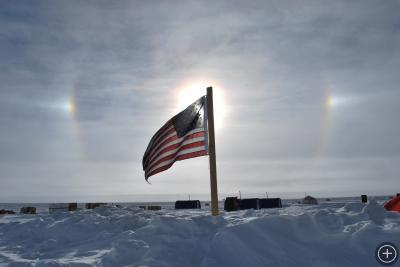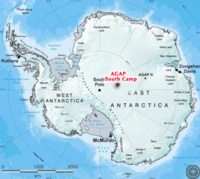Our Series of Unfortunate Events
January 9, 2009
AGAP-SOUTH CAMP, ANTARCTICA– On January 6th, we sat around after dinner discussing how miraculous it was that nothing had gone wrong. This clearly was the cosmic queue for everything to go wrong in the next 27 hours.
First, the inverter blew. The inverter supplies power for the scientific equipment in the plane. Without it, the gravimeter has no blinking lights and collects no data. This flight holds the current record for the shortest flight out of AGAP-south. Beth Burton noticed the lack of power and quickly turned SJB around.

A KBA mechanic works on the left engine of SJB. The plane has been getting a lot of attention lately.
The very next flight, we lost the plane’s tip tanks. In addition to fuel stored near the belly of the plane, there are also gas tanks in the wings. These tip tanks add about 15 minutes of flying capability to any flight out of AGAP and were essential to meeting some of our distant science targets. It was particularly frightening that these pumps malfunctioned when we were considering flying the Recovery Lake lines, which require the use of the plane’s normal tank, the auxillary tank we installed back in McMurdo and the tip tanks.
Finally, in a third stroke of bad luck, we lost the onboard GPS. Without information from our Global Positioning System, we can collect data but we have no idea where we are along the survey line. We know the data represents the Earth… but where on Earth?
Thinking bad things come in 3’s might lead one to believe these would be the end of our troubles but the worst was yet to come. Next the “command center” of the radar system went out. It is as if you were using your home computer and suddenly, you could not see your hard drive anymore. You wouldn’t be able to save new documents, or play your favorite game. It is a situation best described by “Lights on but no one’s home”. Our science team discovered this problem just after I had gotten up for my “night shift” duties. Nick was able to replace the command center and we were still able to fly that day.
Later, in the radar processing, we saw strong vertical offset of the ice sheets internal layers and the bed that lies below. Nick and I set out to investigate this problem by examining an individual radar file from Flight 35, which seemed to be when the problem started. In the end, it turned out that after replacing the radar’s command center, the settings for channel 1 of the radar had been reset but the others (channel 2, 3 and 4) were not set correctly. This was a happy answer to the problem since it meant that we could rescue the data from flights 35-40 if we used channel 1. Not having worked as long or as hard on this project as either Nick, Michael or the PIs at times I feel like the hired help or the free loader who came along because she wanted to be in East Antarctic Field Camp with a population of 31. When I contributed to figuring out why the radar was malfunctioning, that increased my feeling of self worth. I had a moment in which I felt instrumental to ensuring the data quality… not just the making of copies.

This is what the radar looked like after the radar’s command center broke. Fortunately we found the source of this problem and will later be able to recover this data.
Despite all the unfortunate events, the survey has gone well and, I have to say it has gone by fast. It’s hard to believe that we only need 4 more days of good weather to complete our science objectives. It’s hard to put your faith in good weather to make plans for going home but we don’t have much choice. Here’s hoping for clear skies!













Hi Adrienne
Hope everything goes well knowing what happend. Sorry to hear you are experiencing problems but that your survey went well!To remind you, we were the school from England who took part of the webcast in December. We are doing an online school report. Would it be ok if we refered to this story?
Thanks.
Liam,Geoggers at Framingham Earl High school,Norwich,UK.
Hello!
There are always some stumbling blocks on the way to greatness!! we stumbled but we also got the work done! Feel free to use any part of this story you find interesting and let me know if you’d like more details or photos!
Best ~Adrienne